Best Things to do in Zion: Heading to Zion National Park and looking for the best things to do in Zion National Park? I love visiting Zion and have put together this list of Zion attractions that are the best Zion sites.
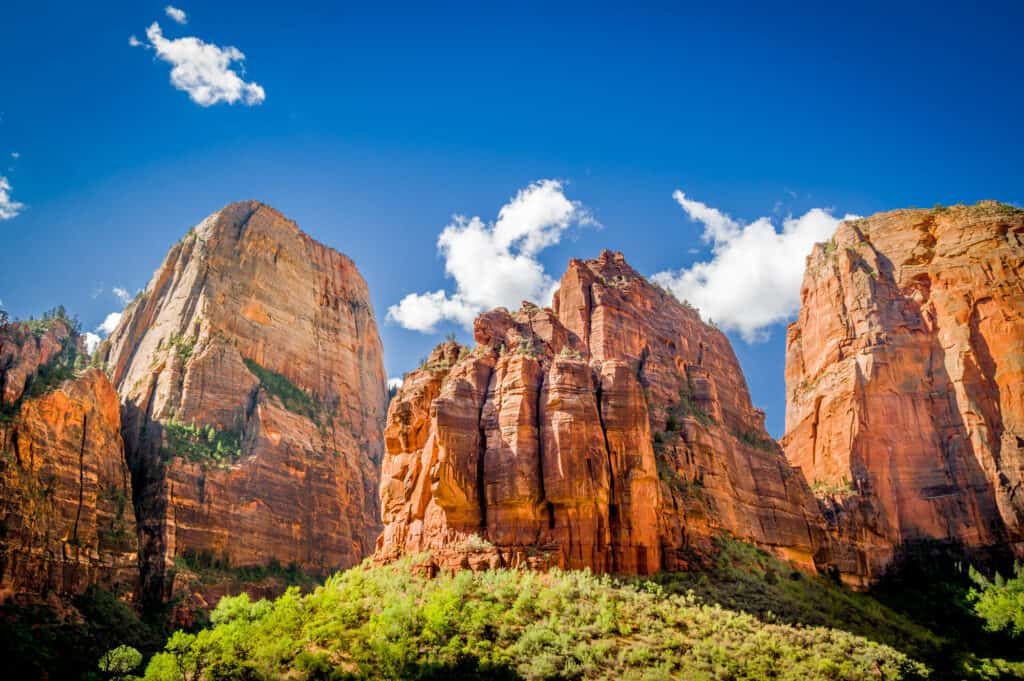
I know planning a trip to Zion National Park can be stressful. That’s why I have written about everything you need to know from renting a car, to where to stay, to one day itineraries for Zion.
Tips for Visiting in Zion National Park
Zion is perfect for outdoor enthusiasts. There is something for everyone on this list and for different fitness levels. Also, note that it is dry and hot (in the summer), and make sure you know what you are getting into before you start. Here are a few tips for visiting Zion:
- Bring a reusable water bottle and lots of water! Remember you are in the sun and you will need to drink lots of water. I love my LifeStraw Filtered Water Bottle. I can refill this bottle anywhere and it comes with a carabiner to connect it to my daypack.
- Check the Weather – days over 100 degrees are very common. Make sure to check.
- Hiking boots or sandals that will protect your feet! I love good shoes. I need all the support and help I can get. I actually love these sandals for hiking and also love these hiking boots.
- Bring hiking poles for balance and to protect your knees. I know many experienced hikers (and even amateur ones) think that hiking poles are for old people who lose their balance. Actually, hiking poles can help when going down steep inclines or when scrambling over rocks. They are great to hike with even for the most experienced hiker.
- Wear a sunhat. I feel like this whole post is about how high you are in the mountains and how much closer you are to the sun but it is so true. At elevation, you are closer to the sun and more likely to burn. Wear sun protection such as a sun hat and sunscreen.
- Be aware of the wildlife. This is the Southwest and you will need to watch out for snakes and other wildlife such as moose or a bear. Please stay away from wildlife and do not feed them. I recommend carrying bear spray as well.
- Start Early – If you want to avoid the traffic and the heat you will need to start your hike early. That way it will be nice and cool and the smog will not affect you either.
- Leave no trace. If you are new to the concept of Leave No Trace it is all about preserving the environment to ensure it is in the same or better condition when you leave it. This means that you should stick to the trails and carry out everything that you carried in. This is a great explanation of the Leave No Trace principles!
- Water shoes are great for water hikes– If you don’t have a pair, I highly suggest it as they are affordable. I have an article on the pros and cons of several pairs of water shoes.
- Bring Bug Spray and a snack: Be sure to bring everything you need including a snack like a protein bar plus BUG SPRAY.
National Park Entrance Fees
To enter the National Parks, you’ll need to pay an entrance fee or have a National Parks Pass also known as American the Beautiful Pass.
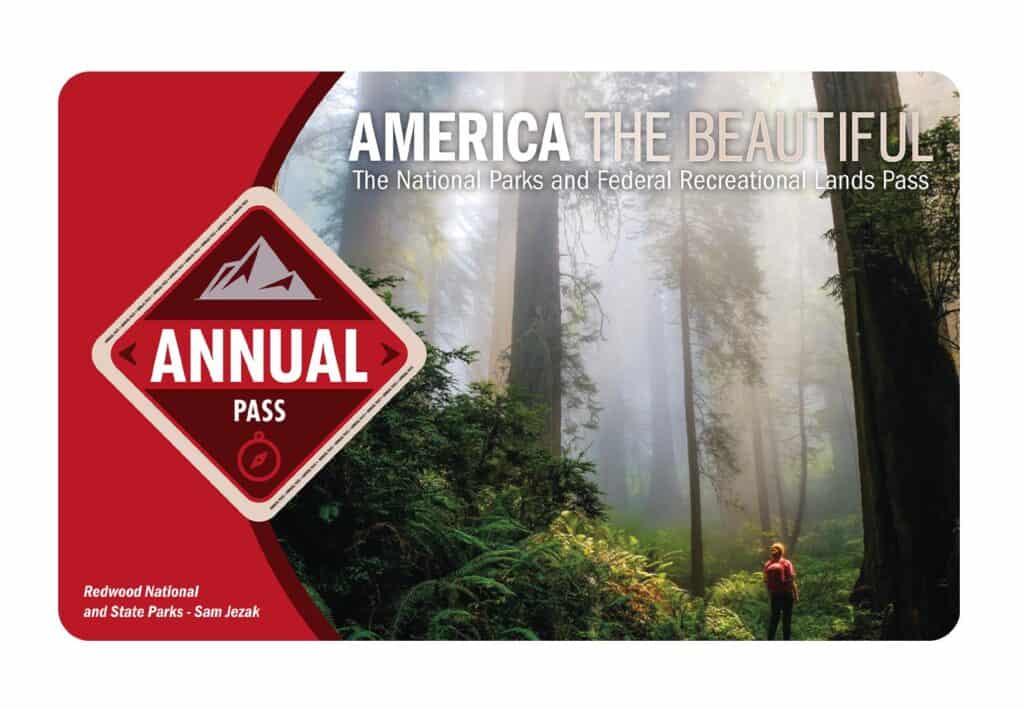
It costs $80 for a yearly America the Beautiful Pass. This gives you access to all national parks and federal areas that charge fees. The America the Beautiful Pass is well worth it!
I purchased my first one in 2016 and it’s such a money-saver! Plus 10% of sale proceeds go to the National Park Foundation.
Tips for Visiting Grand Teton National Park
Grand Canyon National Park is perfect for outdoor enthusiasts. There is something for everyone on this list and for different fitness levels. Also, note that it is dry and hot (in the summer), and make sure you know what you are getting into before you start. Here are a few tips for visiting the Grand Canyon:
- Bring a reusable water bottle and lots of water! Remember you are in the sun and you will need to drink lots of water. I love my LifeStraw Filtered Water Bottle. I can refill this bottle anywhere and it comes with a carabiner to connect it to my daypack.
- Check the Weather – days over 100 degrees are very common. Make sure to check.
- Hiking boots or sandals that will protect your feet! I love good shoes. I need all the support and help I can get. I actually love these sandals for hiking and also love these hiking boots.
- Bring hiking poles for balance and to protect your knees. I know many experienced hikers (and even amateur ones) think that hiking poles are for old people who lose their balance. Actually, hiking poles can help when going down steep inclines or when scrambling over rocks. They are great to hike with even for the most experienced hiker.
- Wear a sunhat. I feel like this whole post is about how high you are in the mountains and how much closer you are to the sun but it is so true. At elevation, you are closer to the sun and more likely to burn. Wear sun protection such as a sun hat and sunscreen.
- Be aware of the wildlife. This is the Southwest and you will need to watch out for snakes and other wildlife such as moose or a bear. Please stay away from wildlife and do not feed them. I recommend carrying bear spray as well.
- Start Early – If you want to avoid the traffic and the heat you will need to start your hike early. That way it will be nice and cool and the smog will not affect you either.
- Leave no trace. If you are new to the concept of Leave No Trace it is all about preserving the environment to ensure it is in the same or better condition when you leave it. This means that you should stick to the trails and carry out everything that you carried in. This is a great explanation of the Leave No Trace principles!
- Water shoes are great for water hikes– If you don’t have a pair, I highly suggest it as they are affordable. I have an article on the pros and cons of several pairs of water shoes.
- Bring Bug Spray and a snack: Be sure to bring everything you need including a snack like a protein bar plus BUG SPRAY.
Where to stay near Grand Canyon National Park
The Grand Canyon makes for a great weekend escape. Fresh air, beautiful scenery and being in nature does a world of good for the soul. I recommend staying as close to the park as possible and even treating yourself with a cabin with a spa pool to relax at night.
- There are lots of fantastic Airbnbs near the Grand Canyon. I have made a list of the best airbnbs around the park wherever you decide to stay. You can also check out my post on Where to Stay near the Grand Canyon to find the perfect hotel for any budget.
If you are taking a road trip remember to reserve a car in advance using Discover Cars .
15 Incredible Things to do in Zion National Park
The Narrows
Located on the North Fork of the Virgin River and upstream of the main canyon, The Narrows is one of the premier hikes in the park and on the Colorado Plateau. It is the narrowest section of Zion Canyon in Zion National Park, Utah, United States.
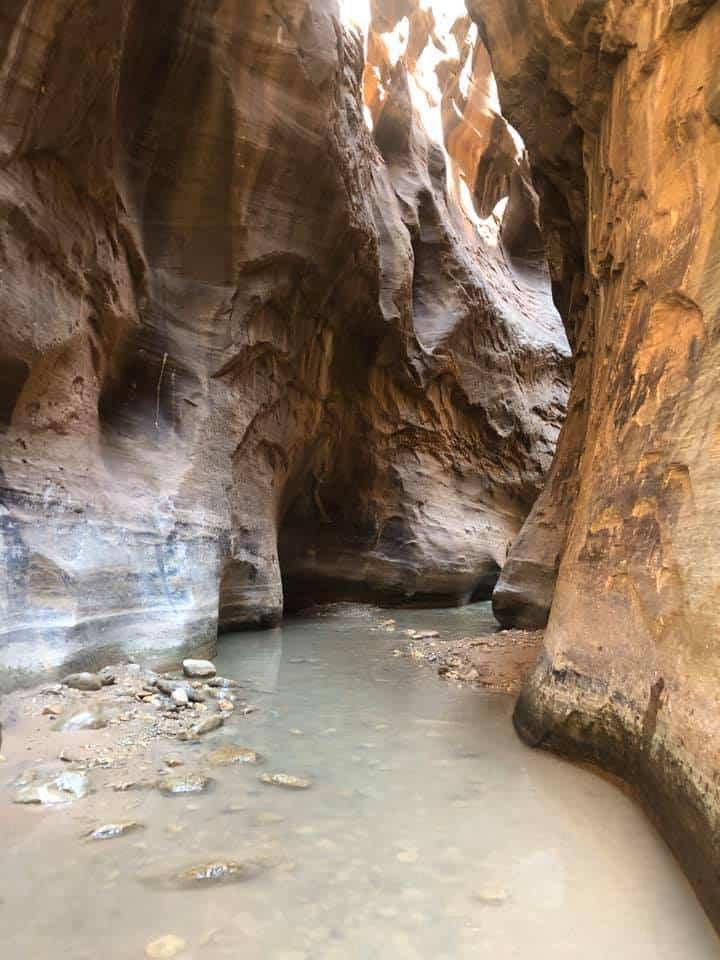
The Narrows, Zion’s hallmark feature, is the slot canyon of all slot canyons, and hikers who don’t mind getting a little wet can follow the Virgin River down this beautiful rock cut. Hikers can hike, walk, and swim in a narrow canyon surrounded by gigantic red sandstone canyon walls, where the Virgin River has been at work for millions of years.
There are at least 3 Ways to Hike the Narrows:
- Overnight Through-Hike from the Top
A fantastic one-night backpacking adventure of The Zion Narrows hike for experienced backpackers is worth it when completed in its entirety. You won’t even need a tent most times of the year!
In addition, the weather forecast must be clear and without the threat of storms or flooding because you’ll be spending the night in the canyon.
A more leisurely way to hike, enjoy, photograph, and explore. Depart from Chamberlain’s Ranch. Shuttle and permit are also required.
- One-Day Through-Hike from the Top
Hike the entirety of the canyon (16 miles) in one day from Chamberlain’s Ranch through a car, shuttle, and permit as these are required.
This is a reasonable option for the athletic, and it makes for a fantastic trip and introduction to Zion. Take another day, if possible, to enjoy this memorable trip, which will allow you to take photos, explore side-canyons, play in swimming holes, and relax in camp.
- Day Hike from the Bottom
Due to its ease as well as little physical commitment, this is the most popular option. You can hike in as far you would like and turn back at any time but Bottom-Up hikers are only permitted to hike as far north as Big Springs. Orderville Canyon is also worth a visit if you have extra time.
You can hike in and out from the Temple of Sinawava via the Riverside Walk to Wall Street and back. You’ll need to ride the shuttle into Zion Canyon, to Temple of Sinawava, and that takes about 45 minutes during the summer season.
It’s an excellent half-day or full-day trek with simple logistics. When a through-hike isn’t possible in the winter, this is a decent solution. A permit is not required for day hiking from the bottom.
Hiking the Narrows is an awesome experience, especially because of the unique terrain and, of course, Zion’s grandeur. Hiking the Narrows with a guide is recommended for individuals who don’t want to miss out on this experience but have never done a hike like this before.
Angels Landing
Angels Landing is the most popular and well-known hike in Zion National Park, leading to one of the park’s most iconic sites. This breathtaking climb will lead you to an incredible vantage point overlooking the canyon. This dramatic journey climbs the side of a mountain on a series of switchbacks known as Walter’s Wiggles before traversing a narrow ridge to a 1,500-foot drop and a view of the valley below.
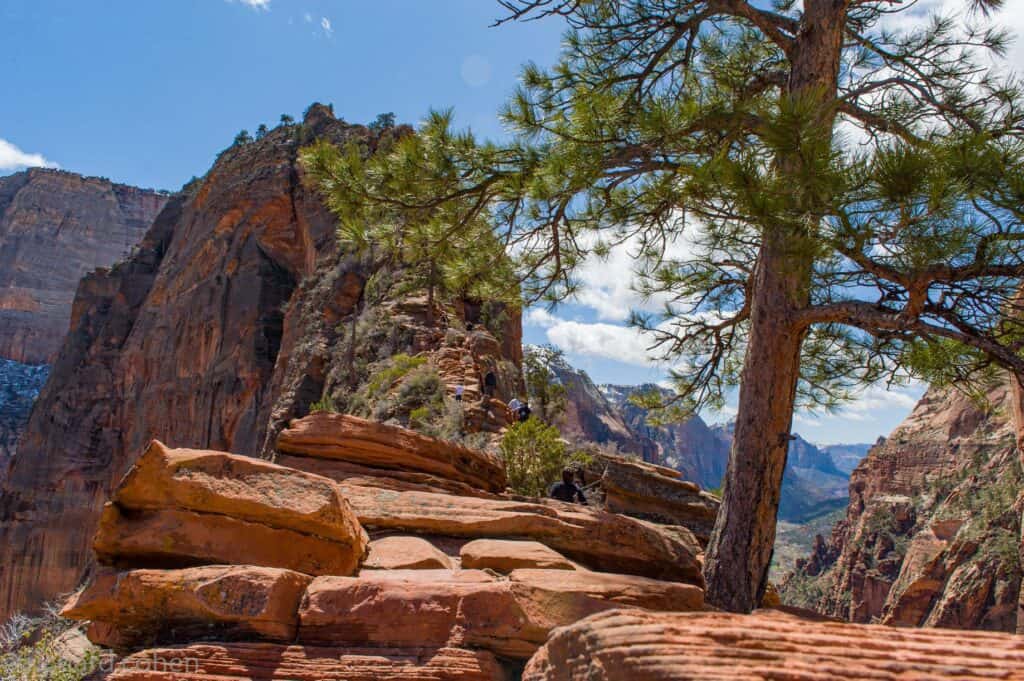
The hike is not recommended for individuals who have a weak heart, fear of heights, and young children as one section of the trail involves holding onto a chain bolted onto a cliffside with sheer drop-offs.
This hike starts at the Grotto and lasts between three to six hours. The trail is open all year, but, it can be extremely hot and crowded in the summer, and in the winter, it can be completely covered in snow.
You’ll be rock climbing to get to the top at its highest points, with a steep drop-off on either side. The trek and views are breathtaking, but all safety precautions must be done. The risk is real so make sure you have the right gear.
Canyon Overlook
Located on the Zion of Mt. Carmel (East), side of the park, the Canyon Overlook trail is one of the most spectacular and relatively easy to access overlooks in all of Zion National Park.
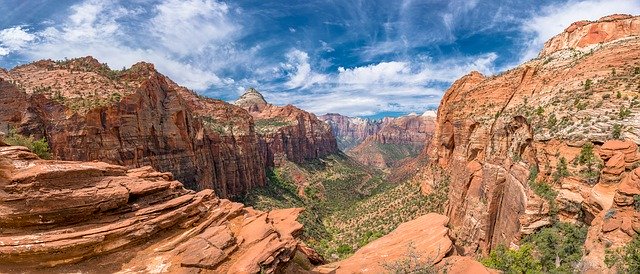
This one-mile hike off the Zion-Mount Carmel Highway leads to a high vantage point with panoramic views of the valley. The trail itself is part of the attraction, curving around the side of a mountain, hugging the cliff wall, swerving out onto a wooden walkway hung over a drop-off, and offering spectacular views around every turn.
The vast of long drops are protected by railings, but some are not. This trail is not suitable for young children because it requires you to negotiate narrow cliffs with no obstacles at points.
The trail begins with a collection of stone steps north of the road, across the street from the parking area on Highway 9 just east of the tunnel. You’ll get a spectacular view of the Pine Creek slot canyon on your way to the viewpoint. There’s also a nice shaded alcove with ferns growing out of the walls that offers a bit of a break from the otherwise exposed path.
Although the trail is relatively flat and well-traveled, it contains switchbacks, steps, and Slickrock despite its short duration as the path also obtains the designation of moderate difficulty. Thus, it is advisable to wear appropriate hiking footwear.
Emerald Pool Trail
Emerald Pools is a must-see in Zion National Park: a desert oasis. The hike consists of a series of smaller pathways that wind their way past a small, lushly-vegetated creek that cascades down from the cliffs, forming numerous interesting “pools.”
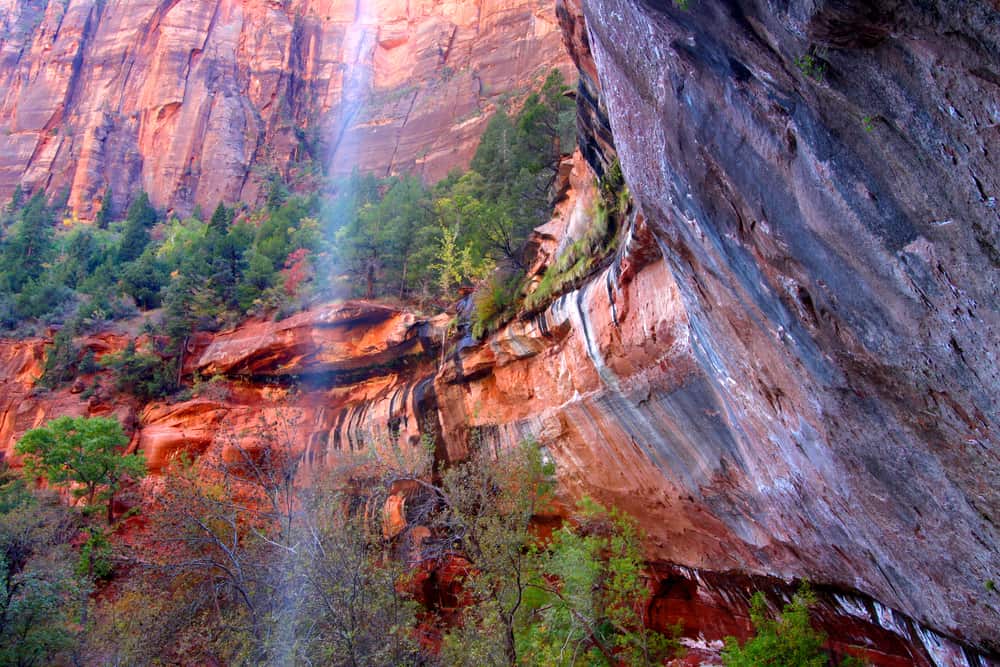
The Emerald Pools hike, beginning at the Zion Lodge shuttle stop, has three sets of pools at different points along the hike:
- Lower Emerald Pools.
The vegetation becomes lusher in less than half a mile (1.5 mi), and the trail winds its way through a steep alcove beneath two tall waterfalls and the pools below. Even the elderly and parents with strollers will find it easy to get to this point.
- Middle Emerald Pools.
The trail becomes more challenging beyond the alcove, including steps up and around to get you to the top of a cliff you just walked under. The streams that generate the waterfalls are in the middle “pools.” This passage is especially beautiful.
- Upper Emerald Pools.
The final quarter-mile stretch is hot and sandy, but it’s worth it to reach the final pool at the base of the 300-foot cliffs above. The upper pool area is a fantastic place to relax and eat lunch by finding a shady boulder. Most of the time, you can see a faint waterfall coming from the mouth of Heaps Canyon far above.
Watchman Trail
The Watchman Trail is a 5.0 kilometer heavily trafficked out and back trail located near Springdale, Utah that features a river and is rated as moderate. The trail is open all year and is generally utilized for hiking, walking, running, and camping.
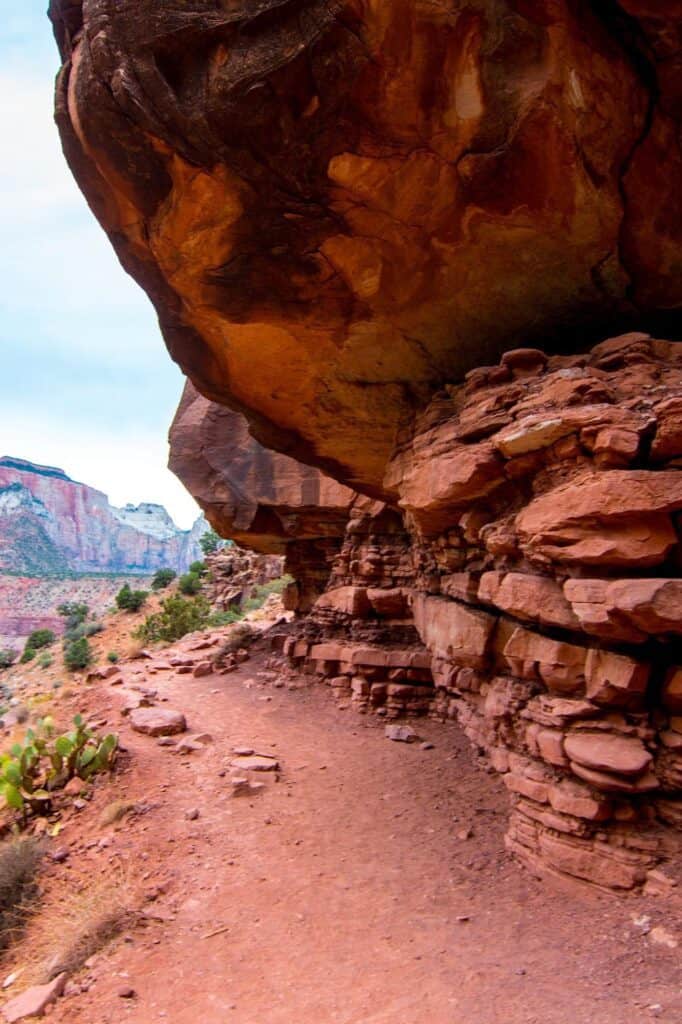
The Trail begins between the Visitor Center and the South Campground and leads to a viewpoint on top of the first tier of cliffs, roughly 300 feet above the canyon floor.
While the trail does not lead to the summit of Watchman Mountain, it does provide a good view of the famed and spectacular peak to the south, as well as a bird’s eye view of the entire Visitor Center complex below.
This trail begins inconspicuously, skirting the river’s banks before heading behind some cottages and building debris. The environment becomes more attractive progressing towards the hills. It becomes moderately strenuous for the next mile, ascending and circling a tiny valley until reaching the first tier of cliffs above the main canyon.
Further, this trail is completely exposed to the sun during the summer. So, this hike is best done on a cloudy day or in the morning when this side of the main canyon is still in the shade.
Riverside Walk
The Riverside Walk, formerly known as The Gateway to the Narrows, is one of Zion’s best family-friendly trails. For about a mile, the trail follows the lovely Virgin River to the mouth of the famous Zion Narrows. This paved trail is ideal for children and adults of all ages and abilities. Wheelchair users will enjoy this walk as well but may require assistance.
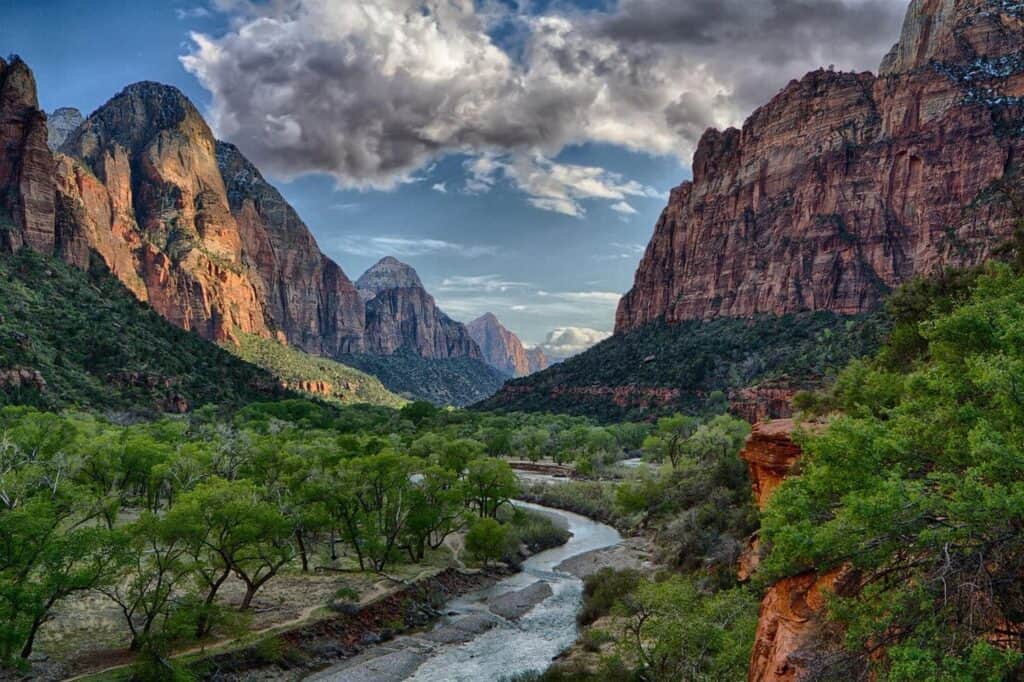
It begins at the Temple of Sinawava, at the far end of Zion Canyon’s generally accessible portion. During the day, cottonwood trees shade the majority of the trail, providing a pleasant shade that is complemented by the cool waters of the North Fork of the Virgin River.
Many of Zion’s exotic species of wildlife can be found in the hanging gardens along the trail’s sloped walls, which are fed by trickling waterfalls. The entrance to the Narrows is at the end of the climb, and most hikers who take the time to stroll down the Gateway spend at least a half-hour or more wading around in the Narrows’ mouth.
The Riverside Walk is a great place to catch a glimpse of the local Zion wildlife. Lizards, birds, and some unusually friendly squirrels are common along the trail. Mule deer sightings are also common, especially in the evening. Keep a safe distance from all wildlife and never feed them.
Hidden Canyon
Tucked away above the main canyon east of the Great White Throne, Hidden Canyon is a beautiful narrow and deep “hanging canyon.” The constructed trail rises the east side of the main canyon, traverses a few ravines, and finishes at the canyon’s mouth, allowing hikers to go as far as they can.
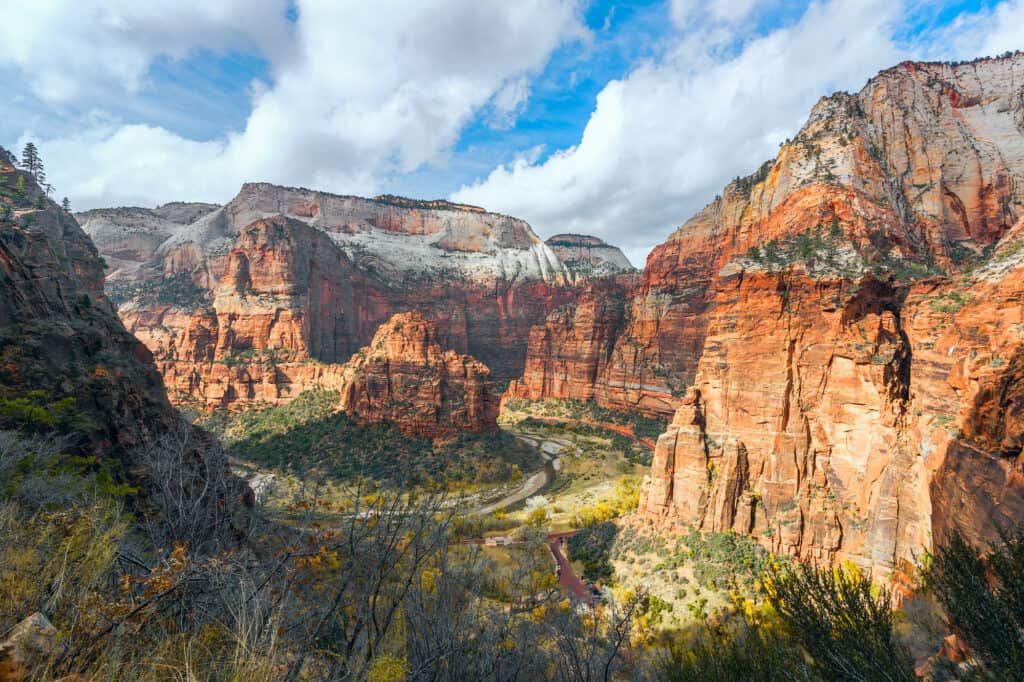
With a return distance of 2.2 miles, it’s a lot less demanding and a shorter hike on its own. If you only want to spend a few hours trekking and aren’t afraid of heights, this is a great alternative.
From the trail intersection, the route zigzags upward before skirting westward around a rocky promontory. It rapidly descends into a tight passage with handrails made of chains in precarious places. As it continues westward above a drop-off of nearly a thousand feet, the road becomes even more nerve-wracking. And after a few hundred yards, the route bends southeast towards Hidden Canyon’s mouth.
However, just recently, a large rockfall has also closed this trail. The staff is, indicating that this will be a long-term closure.
Drive the Mount Carmel Highway
From the South Entrance of Zion National Park to the Mount Carmel Junction with US Route 89, the entire Zion-Mount Carmel Highway is 40 square miles. It was constructed in 1930 to provide better access to the park and to connect visitors to Bryce Canyon, the Grand Canyon, and Zion National Park.
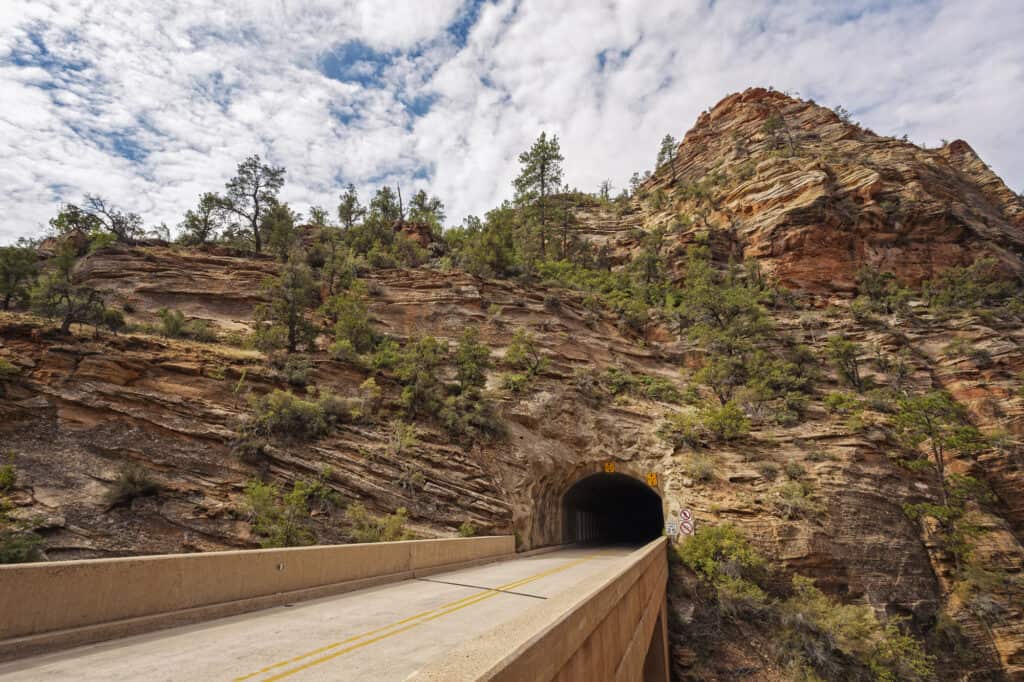
As it climbs up the mountainside, the road follows the cliff wall. The road runs via a narrow 1.1-mile tunnel after a steady climb. Because the tunnel is too narrow for RVs to pass through, traffic is diverted in one way when RVs enter the tunnel. To pass through the tunnel, RV drivers must pay a fee when they enter the park, and a pass must be obtained ahead of time.
Immediately after exiting the tunnel on the east side is the parking area for the Canyon Overlook Trail, a one-mile round-trip hike to an incredible viewpoint over the valley. The terrain transforms to undulating ridged mountains of orange and cream colors beyond this point.
Swirling, otherworldly rock formations, mounds, towers, hoodoos, and hilltops are among the highlights. The terrain, which is speckled with desert pines, sagebrush, and wildflowers, is colored by layered strata of rusty red, orange, cream, yellow, and brown. Water, wind, and ice have molded this environment into the magnificent scene it is today over millions of years.
Visit Zion Human History Museum
Located a one-half mile north of the park’s south entrance on the main park road, or 11 miles west from the east entrance, The Human History Museum is a regular stop on the Zion Canyon Shuttle System from early February through late November.
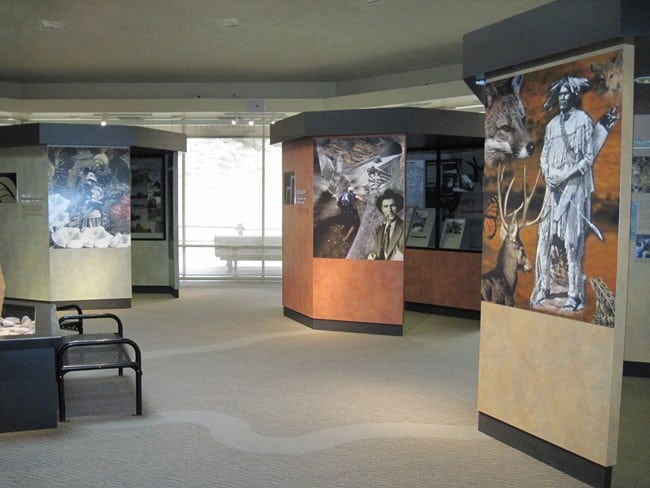
Permanent exhibits at the museum highlight the diverse human civilizations that have inhabited the area over time, including American Indians and pioneers. Every half hour, the museum also shows a 22-minute documentary that gives a summary of the park’s history. Books and souvenirs are available for sale in the bookstore.
To learn about the cultural history of Zion, stop in at the Human History Museum, the first stop on the shuttle bus.
The museum has large, easy-to-read exhibits as well as a massive model of the park and surroundings to put the area into perspective.
Visit Kolob Canyon
Narrow parallel box canyons are cut into the western border of the Colorado Plateau which generate stunning peaks and 2,000-foot cliff walls in the park’s northwest section. Whether you come to see the panoramic scenery from the scenic drive, trek into one of the gorgeous canyons, or embark on a multi-day excursion into the Zion Wilderness, Kolob Canyons has something special to offer for everyone.
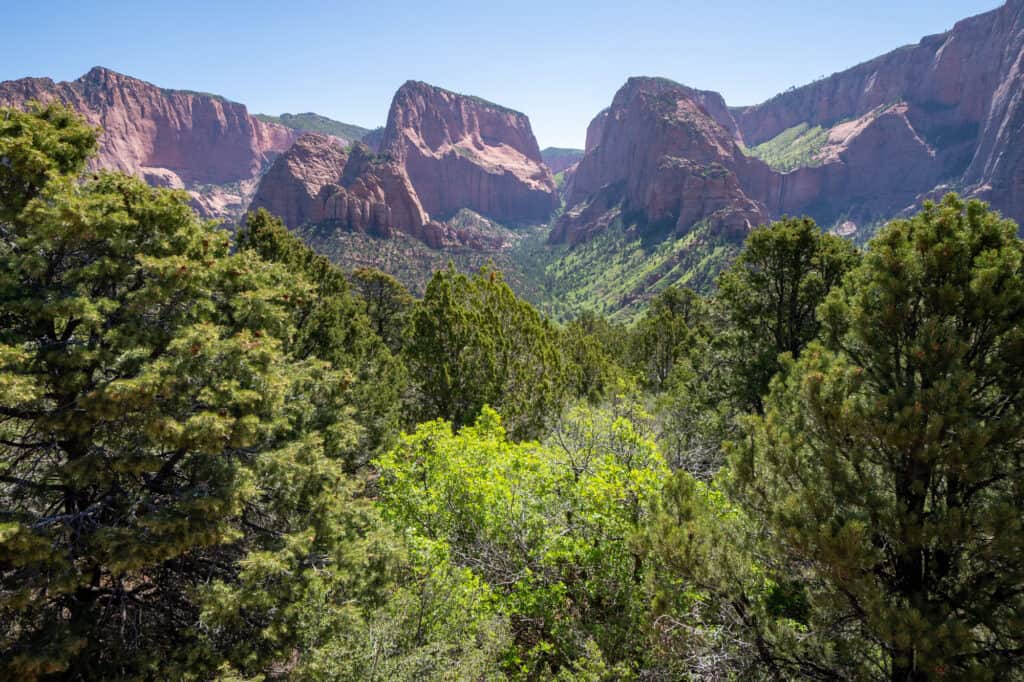
The canyon is relatively small and has several day hikes on different lengths. Beautiful inside and outside is the road leading into the Kolob Canyon featuring a plethora of pull-offs with spectacular panoramic landscapes.
The Kolob Canyons section of Zion National Park is located at Exit 40 on Interstate 15, 40 miles north of Zion Canyon and 17 miles south of Cedar City. Visitors may explore the red canyons and access different trails and gorgeous overlooks along the Kolob Canyons Road, which is a five-mile scenic drive.
Visit Kolob Terrace
Kolob Terrace is a great option for people looking for a new perspective on Zion National Park without all of the development and tourists.
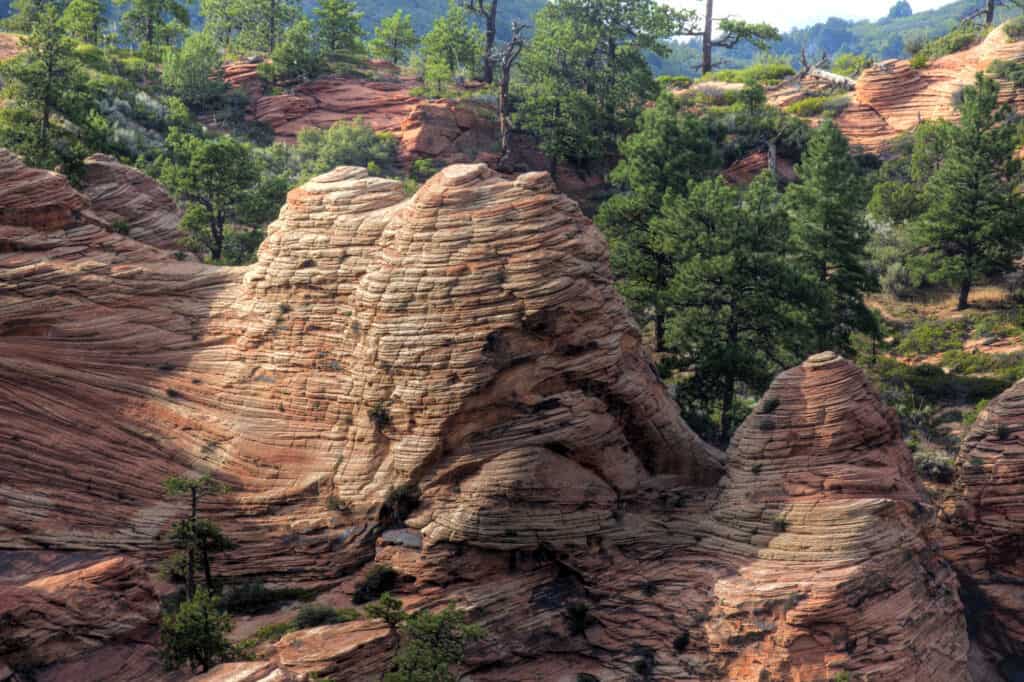
Beginning in the late 19th and early 20th centuries, the Kolob Terrace’s high elevation served as a summer grazing range for ten original families who made it their home throughout the summer months. Some local cattlemen would stage three-day cattle drives from the Arizona Strip to get their herds there and sometimes would leave the cattle on the range into November, which with the leaves off the trees meant better visibility to keep track of their herds but also meant the possibility of blizzardy weather when moving them to lower pastures.
The Left Fork of North Creek, also known as “the Subway,” is located on the Kolob Terrace and is one of Zion’s most popular canyons. At Lava Point, Zion National Park’s highest point, primitive camping is available. The top sections of the Kolob Terrace Road are not plowed during the winter; hence this area of the park is usually closed during the winter.
Kolob Terrace has a special vibe with a wild, free, and secretive character that visitors adore. The Kolob Terrace Road is a rolling, winding red road that begins in the town of Virgin (3,900 ft.) and brings us up layer after layer to the heights of Zion at Lava Point, and beyond to the mountains beyond, is the primary access to Kolob Terrace.
Visit Big Bend
Big Bend is a stunning stop in Zion. There are no hiking trails here but you can see this viewpoint where the Virgin River bends around. Not quite as popular as Horseshoe Bend in Arizona but I think this stop is underrated.
Check out one of the Magnificent Viewpoints in Zion – Observation Point, Angel’s Landing, Canyon Overlook, West Rim Trail, Canyon Junction Bridge
- Observation Point
This eight-mile round-trip climb is one of the best for breathtaking views and an exceptional view of Zion Canyon. This is a strenuous hike up to and into Echo Canyon, past dramatic drop-offs and Zion’s gorgeous Navajo sandstone.
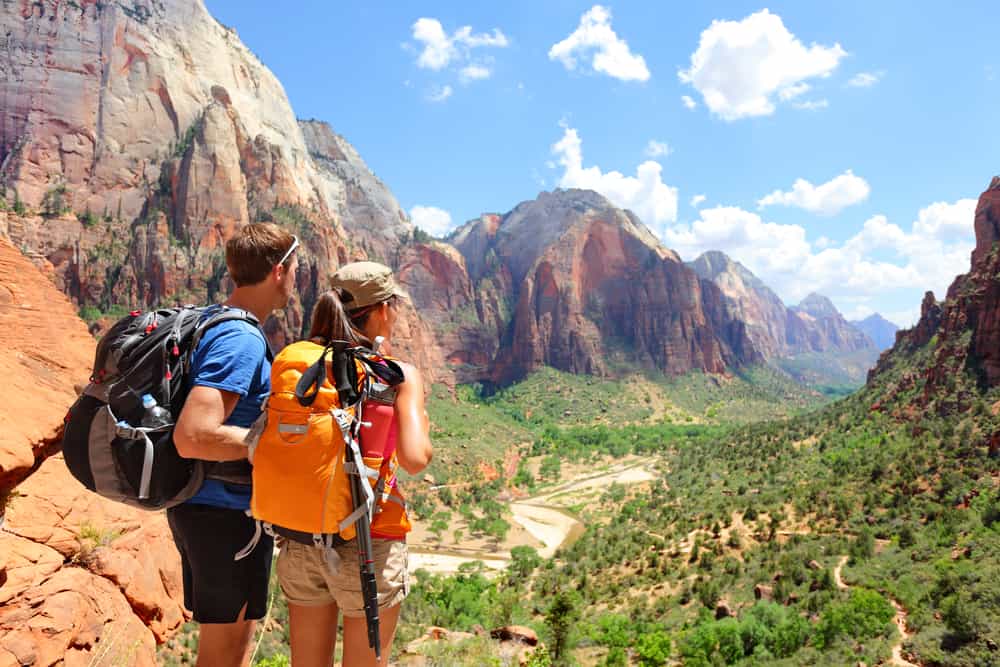
Observation Point itself is perched high above Zion Canyon and is the most accessible of the rimrock overlooks that line the canyon wall. The trail begins by zigzagging vigorously up an amphitheater carved out of the wall of Zion Canyon by the river. About two-thirds of the way up the grade, a spur trail climbs southward into the cleft of Hidden Canyon.
It’s longer and higher, but it’s also less crowded and takes you through some spectacular canyon vistas.
- Angel’s Landing
Angels Landing is the most popular and well-known hike in Zion National Park, leading to one of the park’s most iconic sites. This breathtaking climb will lead you to an incredible vantage point overlooking the canyon. This dramatic journey climbs the side of a mountain on a series of switchbacks known as Walter’s Wiggles before traversing a narrow ridge to a 1,500-foot drop and a view of the valley below.

The hike is not recommended for individuals who have a weak heart, fear of heights, and young children as one section of the trail involves holding onto a chain bolted onto a cliffside with sheer drop-offs.
This hike starts at the Grotto and lasts between three to six hours. The trail is open all year, but, it can be extremely hot and crowded in the summer, and in the winter, it can be completely covered in snow.
You’ll be rock climbing to get to the top at its highest points, with a steep drop-off on either side. The trek and views are breathtaking, but all safety precautions must be done. The risk is real so make sure you have the right gear.
- Canyon Overlook
Located on the Zion of Mt. Carmel (East), side of the park, the Canyon Overlook trail is one of the most spectacular and relatively easy to access overlooks in all of Zion National Park.

This one-mile hike off the Zion-Mount Carmel Highway leads to a high vantage point with panoramic views of the valley. The trail itself is part of the attraction, curving around the side of a mountain, hugging the cliff wall, swerving out onto a wooden walkway hung over a drop-off, and offering spectacular views around every turn.
The vast of long drops are protected by railings, but some are not. This trail is not suitable for young children because it requires you to negotiate narrow cliffs with no obstacles at points.
The trail begins with a collection of stone steps north of the road, across the street from the parking area on Highway 9 just east of the tunnel. You’ll get a spectacular view of the Pine Creek slot canyon on your way to the viewpoint. There’s also a nice shaded alcove with ferns growing out of the walls that offers a bit of a break from the otherwise exposed path.
Although the trail is relatively flat and well-traveled, it contains switchbacks, steps, and Slickrock despite its short duration as the path also obtains the designation of moderate difficulty. Thus, it is advisable to wear appropriate hiking footwear.
- West Rim Trail
The West Rim Trail is a 15-mile trail that runs along the upper west plateau and connects Lava Point (Zion’s highest point) with the Grotto Trailhead in the park’s popular main canyon.
Most tourists to Zion are familiar with the lower stretch of the West Rim Route that leads to the iconic Angels Landing trek, but those willing to hike farther up the trail will be greeted with even more spectacular views as the trail weaves its way through the magnificent sandstone formations.
The West Rim Trail follows along the rim with views of Phantom Valley and the canyons to the south. The Telephone Canyon Trail provides a shortcut between Potato Hollow and Cabin Spring or a possible loop for hikers entering and exiting the same trailhead. At Cabin Spring the trail begins a steep drop in elevation and descends 2,500 feet over 4.7 miles ending at the Grotto Picnic Area.
The greatest times to hike this trail are in the late spring, summer, and fall. The trail is usually covered in deep snow in the winter, which can last until late April. Only authorized camping areas are available.
- Canyon Junction Bridge
One of the best sites to watch the sunset in Zion is Canyon Junction Bridge. The ease of getting here as well as breathtaking views make this a wonderful spot to watch the sunset from! The bridge is before the Highway 9 junction with Zion Canyon Scenic Drive at Zion Valley’s core. Alternatively, you can reach the Canyon Junction bridge by following the Pa’rus route from the main parking area.
A magnificent sunset is created by the Virgin River in the foreground and The Watchman in the backdrop. If it’s a gloomy night, the sunset could be particularly moody.
Visitors can drive here and await the sunset. Getting there early as there will be many photographers is recommended.
Recent Posts
15 Tips for Visiting the Grand Canyon in September – 2023 Ultimate Guide
Visiting the Grand Canyon in September is a great time to visit. September is a busy time to visit but the crowds are starting to arrive especially toward the end of the month. I’ve included...
15 Tips for Visiting the Grand Canyon in August – 2023 Ultimate Guide
Visiting the Grand Canyon in August is a great time to visit. August is a busy time to visit but the crowds are starting to arrive especially toward the end of the month. I’ve included all...
